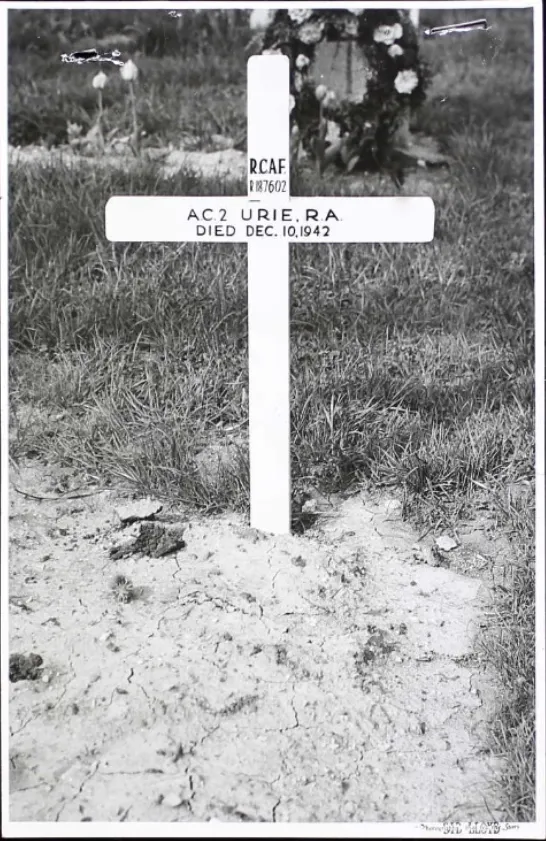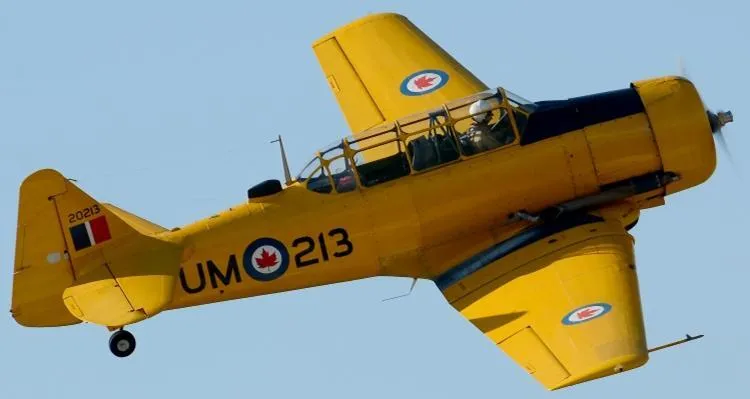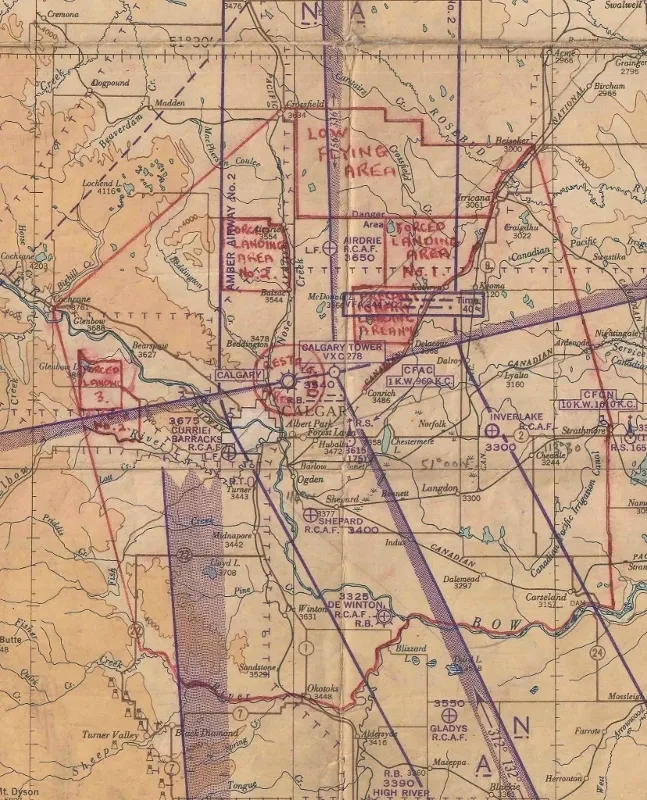Urie, Rowland Albert (Aircraftman 2nd Class)
Killed in Flying Accident 1942-October-12


Birth Date: 1922-March-21
Born:
Parents: Son of Albert Edwin and Blodwen May Urie, of Windsor.
Spouse:
Home: Windsor, Ontario
Enlistment:
Enlistment Date: unkown date
Service
RCAF
Unit
37 SFTS- Service Flying Training School (RAF)
Base
Rank
Aircraftman 2nd Class
Position
aero engine mechanic
Service Numbers
R/187602
Home
This incident involved multiple aircraft:
- Harvard Mk. II Serial: AJ898
- Harvard Mk. II Serial: AJ854
All the above aircraft in the above list are referenced in this report.
Crew or Other Personnel
Harvard AJ898
Accident Card - North American Harvard Mk. II serial:AJ898
This accident involved 2 aircraft on 1942-October-12. They are: Harvard II s/n AJ898, Harvard II s/n AJ854.
This accident involved 3 people. Cromack HC, Phelps AI, Warner RF
This accident had 4 fatalities. Leading Aircraftman Hubert Cecil Cromack RAFVR Killed in Flying Accident service no:1125880 Harvard AJ854,Aircraftman 2nd Class Rowland Albert Urie RCAF Killed in Flying Accident service no:R/187602 Harvard AJ898, Flight Lieutenant Robert Julius Warner RAFVR Killed in Flying Accident service no:77954 Harvard AJ898, Flying Officer Anthony Irving Phelps RAFVR Killed in Flying Accident service no:103007 Harvard AJ898
Harvard serial: AJ898

Canadian Warplane Heritage Museum
The North American Harvard appeared in 1937, in response to a US Air Corps proposal for an advanced trainer. The first of 50 Harvard Mk. Is ordered by the Canadian Government were delivered to RCAF Sea Island, BC in July 1939. By early 1940, the Mk. II was being assembled in California with an all metal fuselage replacing the original tube and fabric structure. 1200 Mk. IIs were supplied from US sources, until Canadian built Harvards started being produced in 1941.
In August 1938, Noorduyn Aviation of Montreal farsightedly signed an agreement with North American, to build the Harvard under licence. When the British Commonwealth Air Training Plan (BCATP) came into being in December 1939, Noorduyn received its first orders and went on to produce nearly 2800 Harvard Mk. IIBs for the RCAF and the RAF, between 1940 and 1945. In Canada, Harvard Mk. IIBs were used as advanced trainers with the BCATP at fifteen Service Flying Training Schools across the nation. They helped pilots make to the transition from low powered primary trainers, like Fleet Finch or the de Havilland Tiger Moth, to high performance front line fighters such as the Spitfire.
At the end of WW II, although the RCAF retained the Harvard as a trainer, a large number of them were sold off to civilian operators. The RCAF soon regretted this, for by 1949 the Cold War with the Soviet Union was in full swing and the RCAF urgently needed trainers again. 100 T-6J Texans were leased temporarily from the USAF and a further 270 Harvards, the Mk. IV version, were ordered from Canadian Car & Foundry, Thunder Bay. The RCAF used the Harvard Mk. IV for a further fifteen years, before finally retiring it in 1966.
A total of 20,110 Harvards were built between 1938 and 1954, 3,370 of them in Canada. Countless numbers of privately owned Harvards are still flying today.
Canadian Warplane Heritage Museum's Harvard Mk. IV was built by Canadian Car & Foundry, Thunder Bay, Ontario in late 1951. The aircraft saw service at four RCAF flying schools across the nation until it was sold to a civilian owner in 1965. It was the third aircraft to join the Museum after Dennis Bradley, Alan Ness and John Weir donated it in 1973. Canadian Warplane Heritage Museum
Aircraft Images
Harvard AJ898
Harvard Mk. II AJ898
Delivered to stored reserve, issued to No. 39 Service Flying Training School at Swift Current, Saskatchewan on 17 December 1941. Category C4 damage at Swift Current at 20:05 on 26 January 1942. Category C3 damage at Swift Current at 21:30 on 16 April 1942. Crashed at 11:25 on 12 October 1942 after colliding with Harvard AJ854 at 500 feet, 1.5 miles west of relief field at Airdrie, Alberta. Both aircraft with No. 37 Service Flying Training School at Calgary, Alberta. All 3 occupants of the two aircraft killed. Some confusion on who was in what aircraft, see AJ854. Flight Lieutenant R.J. Warner may have been lone occupant of this aircraft.1941-11-11 Taken on Strength No. 4 Training Command 2019-08-20
1942-January-26 Accident: 39 Service Flying Training School Loc: Swift Current Names: Kjeldbech | Middleton
1942-April-16 Accident: 39 Service Flying Training School Loc: Aerodrome Names: Green
1942-June-24 Accident: 39 Service Flying Training School Loc: Aerodrome Names: Peacock | Silva-white
1942-July-16 Accident: 39 Service Flying Training School Loc: R1 Staldwyn Names: Alderton | Gregg
1942-August-07 Accident: 39 Service Flying Training School Loc: Aerodrome Names: Carlisle | Dearling
1942-August-24 Accident: 39 Service Flying Training School Loc: Aerodrome Names: Thomas
1942-October-12 Accident: 37 Service Flying Training School Loc: Airdrie Names: Cromack | Phelps | Warner
1943-03-02 Struck off Strength Struck off, reduced to spares and produce by No. 10 Repair Depot 2019-08-20
Harvard AJ854
Harvard Mk. II AJ854
Delivered to stored reserve, issued to No. 39 Service Flying Training School at Swift Current, Saskatchewan on 17 December 1941. Category C14 damage at Swift Current aerodrome at 15:00 on 23 March 1942. Crashed at 11:25 on 12 October 1942 after colliding with Harvard AJ898 at 500 feet, 1.5 miles west of relief field at Airdrie, Alberta. Both aircraft with No. 37 Service Flying Training School at Calgary, Alberta at the time. All 3 occupants of the two aircraft killed, including Leading Aircraftman H.C. Cromack, RAFVR in this aircraft. Crew also reported as Flying Officer A.I. Phelps in this aircraft along with Cromack.1941-11-03 Taken on Strength No. 4 Training Command 2019-08-20
1942-March-23 Accident: 39 Service Flying Training School Loc: Aerodrome Names: Jackson | Sleep
1942-October-12 Accident: 37 Service Flying Training School Loc: Airdrie Names: Cromack | Phelps | Warner
1943-03-12 Struck off Strength Struck off, reduced to spares and produce by No. 10 Repair Depot 2019-08-20
Unit Desciption
37 SFTS (37 Service Flying Training School)
Graduates of the EFTS "learn-to-fly" program went on a Service Flying Training School (SFTS) for 16 weeks. For the first 8 weeks the trainee was part of an intermediate training squadron; for the next 6 weeks an advanced training squadron and for the final 2 weeks training was conducted at a Bombing & Gunnery School. The Service schools were military establishments run by the RCAF or the RAF.
There were two different types of Service Flying Training Schools. Trainees in the fighter pilot stream went to an SFTS like No. 14 Aylmer, where they trained in the North American Harvard or North American Yale. Trainees in the bomber, coastal or transport pilot stream went to an SFTS like No. 5 Brantford where they learned multi-engine technique in an Airspeed Oxford, Avro Anson or Cessna Crane.

Noteable RAF Instructor pilots based at No. 37 SFTS during the war, was F/O Peter Middleton, the grandfather of Catherine Middleton who is now the Duchess of Cambridge and the wife of Prince William.
For More Information on RCAF Station Calgary see here
RCAF.Info - RCAF Station Calgary AB
RCAF.Info - Relief Landing Field Airdrie AB
RCAF.Info - Relief Landing Field Inverlake AB
![]() Bomber Command Museum Of Canada - 37 SFTS
Bomber Command Museum Of Canada - 37 SFTS
Calgary Wings SFTS37 History
![]() Clarence Simonsen - Calgary Wings 37 SFTS History.pdf
Clarence Simonsen - Calgary Wings 37 SFTS History.pdf
![]() YouTube - Valour Canada Aerodrome of Democracy
YouTube - Valour Canada Aerodrome of Democracy
![]() YouTube - GHOSTS OF THE FOOTHILLS - The BCATP's Hidden Legacy in Alberta
YouTube - GHOSTS OF THE FOOTHILLS - The BCATP's Hidden Legacy in Alberta

